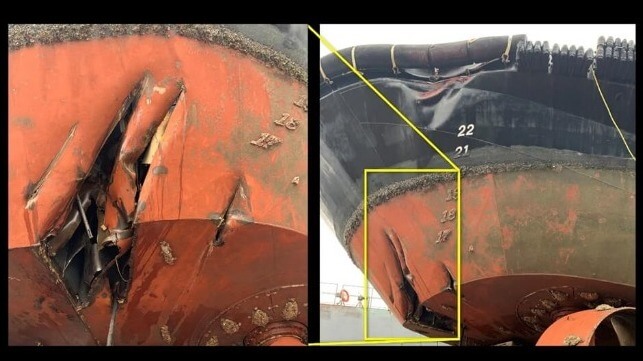NTSB: High Speed Contributed to Escort Tug's Collision With Ship's Prop

High speed was a significant factor in a serious casualty involving an escort tug in the Corpus Christi Ship Channel last year, according to the National Transportation Safety Board (NTSB). The tug was already operating near its maximum speed at the start of the evolution, and did not have enough extra power to get away when things started to go wrong.
“We have recently seen incidents across industry, and the common factor is operators trying to perform advanced maneuvers at high speeds, which gives a higher risk factor with no reward,” operator G&H Towing told NTSB after the casualty.
On January 22, 2023, the ASD tug Mark E. Kuebler and four other harbor tugs were dispatched to assist the Saudi tanker Nisalah, which was inbound on the Corpus Christi Ship Channel. The vessel had pilots aboard for a transit to South Texas Gateway Terminal in Ingleside, where she was scheduled to load a cargo of crude. The vessel was in ballast condition.
The Mark E. Kuebler was assigned to take the starboard quarter position during the escort evolution. The mate had the conn, and he decided to approach the tanker with the tug moving stern-first, which would give the tow line the most favorable lead to the chock on the tanker's starboard quarter. The mate's plan was to make up tow with the tug's bow winch to the chock, then complete the transit to the terminal while moving astern. This arrangement would position the tug alongside the tanker's parallel midbody and away from the flare of the stern during the rest of the transit.
All six vessels were moving through the channel at a speed of about 10 knots. As the Kuebler's mate maneuvered off the tanker's starboard quarter and began to spin the tug through 180 degrees, the tugboat was drawn back towards the Nisalah's stern by hydrodynamic suction forces. The mate increased power but could not prevent the Kuebler from being pulled towards Nisalah's prop. Seconds later, the pilots on Nisalah's bridge heard a noise as Nisalah's propeller cut into the Kuebler's hull. From start to end, this sequence of events took about 60 seconds.
The master of the Kuebler relieved the mate and took over the helm, and initially he thought that the damage was limited to the tug's mast. He radioed the pilots and said that all was fine and the escort job could continue. However, he soon radioed back and reported a bilge alarm. The crew checked the tug's machinery compartment, and they found significant flooding in the Z-drive compartment.
As the tug faced a real risk of sinking due to the flooding, the captain of the Kuebler decided to intentionally ground the vessel on a bank outside of the ship channel. Nisalah continued on to the oil terminal as planned.
The contact with Nisalah's propeller ruptured Kuebler's hull, puncturing the aft peak tank and the Z-drive compartment. Both spaces filled to the waterline, damaging equipment.
The damage to the Kuebler cost about $3 million to repair, plus another $1 million in salvage costs to retrieve the vessel from the bank. The Nisalah's propeller was warped by the impact, and the bill for the tanker's repairs ran to nearly $4 million.
The primary cause of the casualty was high speed, according to NTSB. When the tug was drawn towards the tanker's stern by hydrodynamic forces, it did not have enough reserve power to pull away - because it was already moving about as fast as it could. If all six vessels had been moving at a statelier pace, NTSB said, the casualty might not have happened.
"Owners and operators of Z-drive tugboats that perform harbor-assist operations should set speed limits for advanced maneuvers such as stern-first approaches," advised NTSB. "Tugboat operators should communicate these limits to ship masters or pilots."
Operator G&H Towing agreed, and it has implemented a seven-knot speed limit for stern-first landing for its escort tug fleet.
